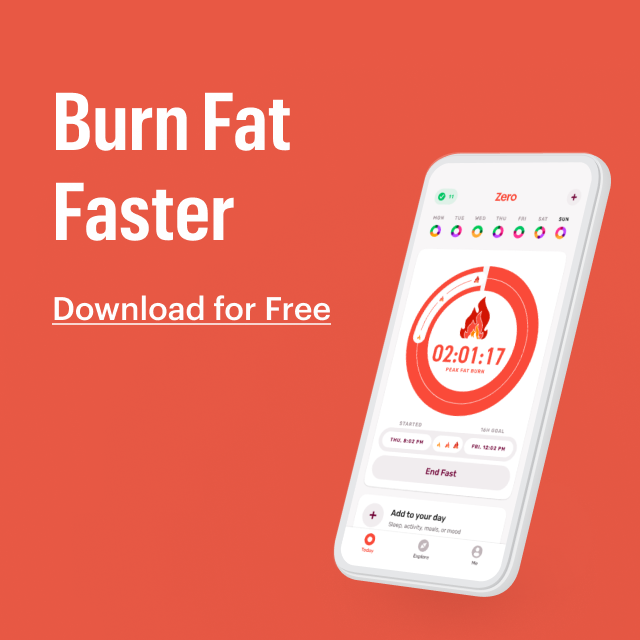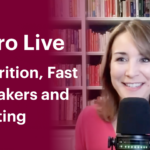Written and medically reviewed by Rich LaFountain, PhD
New fasters have a range of timing options to choose from, which can make it hard to decide where to start. If you’re a beginner, consider a 14:10 fasting protocol as an on-ramp to weight loss and health gain.
Read on to learn all about 14:10 intermittent fasting, including benefits, tips and tricks, and frequently asked questions.

What Is 14:10 Intermittent Fasting and How Does It Work?
14:10 is a type of intermittent-fasting (IF) protocol in which you fast for 14 hours and subsequently consume all your calories within a 10-hour eating window. 14:10 IF, like 16:8 IF, has promising human-research data to support its use as a metabolism-boosting nutrition strategy.
Note: Fasting less than 24 hours is often referred to as time-restricted feeding (TRF) or time-restricted eating (TRE). You may also have seen 14:10 TRF or 14:10 TRE elsewhere — these terms are the same as 14:10 IF.
How Is 14:10 Fasting Different from Other Fasting Methods?
In comparison to a 16:8 fast, you fast for two hours less on a 14:10 IF protocol, so it may be less challenging than longer methods, like the 18:6 or even the 20:4. With IF, the condensed eating window can make meeting your nutrition requirements more challenging. If that’s a concern, 14:10 can be helpful as it gives you a couple more hours to hit your goals for the day.
Research has shown that even in first responders, like firefighters with erratic schedules, 14:10 IF is a great option that combines the health benefits of fasting with the ability to fit into a busy lifestyle or one with intense occupational demands.
The Science Behind 14:10 Intermittent Fasting
When you fast for at least 12 hours, your blood-sugar levels return to baseline levels. Low blood glucose levels provide a signal to the body to ramp up fat-burning. Unlike glucose which is more quickly metabolized for energy, fat is a slow and steady fuel source. When your fat metabolism is the primary means of energy production you will probably notice better energy stability. With a 14 hour fast, you give your body some time to benefit from being in the fasted state. The science behind 14:10 IF suggests that during this time cellular function throughout your entire body is altered. Emerging data indicates that humans are most metabolically healthy when they are able to efficiently shift in and out of states where glucose (fed) or fat (fasted) are primary energy sources. There is a yin and yang relationship between glucose and fat burning energy systems and IF strategies like 14:10 can help balance these two metabolic states.
The Benefits of 14-Hour Intermittent Fasting
Intermittent fasting strategies including 14:10 IF have been shown to improve metabolic health. A healthy metabolism is connected to lower risk of diabetes, cancer, heart disease, and neurodegenerative diseases and conditions. There are many benefits of 14:10 IF, but it is important that you identify the right fasting practice for your health needs and lifestyle preferences.
Weight Loss and Improved Metabolism
14:10 IF is an effective strategy for weight loss and metabolic health. A recent randomized trial showed that individuals following a 14:10 IF schedule spontaneously reduced calories (without calorie tracking) by -425 calories per day. In the same 12 month study participants 14:10 IF led to decreased fat mass, reduced waist circumference, and BMI. In addition, a shorter duration study of six weeks in resistance trained firefighters improved metabolic health markers. 14:10 IF is a strategy that offers a simple, yet effective, method to balance feeding-fasting cycles while improving fat metabolism important to metabolic health.
Improved Insulin Sensitivity
Recent research indicates that only 7% of adults are metabolically healthy. Several IF studies in humans demonstrate insulin sensitivity improvements which are associated with healthy metabolic function. At a time when 93% of adults have elevated risk of metabolic syndrome, IF strategies such as 14-hour intermittent fasting offers an accessible, free, solution to improving metabolic function, glucose handling, and insulin sensitivity markers.
Enhanced Autophagy and Cellular Repair
Autophagy processes in your body’s cells are regulated in large part by energy sensing pathways. Fasting is one of the most reliable ways to promote autophagy throughout the entire body. During autophagy your body will clean up, clean out, renew, or repair cellular structures. I Based upon the research in order to produce measurable changes in markers and genes associated with autophagy you must fast a minimum of 17 to 18 hours. Since autophagy operates as more of a dimmer switch, it’s possible there are extremely low levels of autophagy occurring with shorter fasts, but we do not have confirmation study data in humans at this time.
Improved Digestion
One of the notable benefits of practicing IF, including adopting a regular 14-hour fasting schedule, is its positive impact on gut health and digestion. By adhering to a specific eating window and allowing a fasting period of 14 hours, individuals can give their digestive system a much-needed rest. This break from constant food consumption allows the body to focus on other crucial functions, such as cellular repair and detoxification.
Increased Energy
Fasting for either 12 hours or 16 hours can promote fat burning. During a fast, the body depletes its stored glycogen and begins to rely on stored fat for energy. While both 12-hour and 16-hour fasting can promote fat burning, it’s possible that a 16-hour fast may be more effective. This is because the longer fasting period may lead to a greater depletion of glycogen stores, which can trigger higher levels of fat burning. If you want to burn more fat, the research shows that it’s important that you give your body more time to shift your metabolism towards prioritizing fat as a primary fuel source with fasts that are greater than 12 hours. Moderate exercise during your fast is another great way to burn more stored fat.
Better Sleep
Adhering to a consistent eating pattern within a specific time window can help regulate circadian rhythm, the internal body clock that governs sleep-wake cycles. 14:10 IF can help you to align your eating schedule more closely with natural light dark cycles which contributes to a more consistent sleep-wake cycle, allowing for deeper and more restorative sleep. Starting your fast a few hours after dinner, in the early evening hours can also contribute to the production of melatonin, the hormone that helps regulate sleep. Fasting is important to sleep because it helps synchronize your cellular clock genes. It also reduces late night snacking, and regulates hormone levels, all of which improves your sleep quality.
Reduced Inflammation and Oxidative Stress
Fasting is known to reduce inflammation and oxidative stress within the body, and that includes 14:10 IF. Inflammation and oxidative stress are underlying causal factors in age-related chronic diseases. Intermittent fasting has been shown to activate certain cellular repair processes, like autophagy. In addition while fasting your body will boost ketone production which is linked with increased fat burning. Ketones may be used as a fuel, but more equally important is their role in signaling anti-inflammatory pathways. 14:10 IF improves your body’s protection against inflammation and enhances antioxidant defenses which reduce or block oxidative stress.
Improved Mental Clarity
Study data suggest that intermittent fasting can have positive effects on brain health. It may improve cognitive function, protect against neurodegenerative diseases, and promote the growth of new nerve cells. IF is a powerful nutrition tool that has been shown to reduce neurodegenerative disease risk in large part due to the improvements in metabolic flexibility. A growing number of researchers and clinicians acknowledge that poor metabolic function is a leading contributor to energy crises in the brain and nervous system which impacts mental clarity and disease risk. Intermittent fasting can keep the brain properly fueled which helps improve cognitive function and mental clarity.
Getting Started with 14:10 Intermittent Fasting
In order to get started with 14:10 IF you simply need a way to keep time. You can start whenever you’re ready. If you want a helpful app to provide accountability, track your progress, learn, and join in challenges consider downloading Zero.
Choose Your Fasting Window
When selecting an eating window for 14:10 IF, it’s important to consider your individual health needs/goals, lifestyle preferences, and logistics like your personal schedule. Consider your own preferences and leave some room for flexibility to test different schedules to see what works best. Some individuals find it more comfortable to have an earlier eating window, while others prefer a later one. Pay attention to how your body responds to different eating windows and adjust accordingly.
Adjust Your Meal Times
For 14:10 IF you are effectively skipping one traditionally scheduled meal, such as breakfast or dinner. You additionally would need to avoid late night snacking. Many people find that they enjoy skipping early breakfast in favor of a fast breaker in the late morning. 12pm to 8pm is a fairly common 16:8 eating window, but for 14:10 IF you can have a late morning fast breaker around 10am and start your fasting timer at 8pm.
Making the Most of Your Feeding Window
If you are doing any IF, then you should experience a secondary benefit in that your drive to emphasize high quality food during your eating window is increased. If your eating window is condensed then you must be efficient in that time to meet your nutrition and energy needs. This inevitably leads to less discretionary calories being consumed.
Track Your Fast
Zero is a great tool for tracking your fast. Previous research studies (including the 14:10 IF firefighter research studies referenced above) relied exclusively upon Zero to support first-responder participants in building a successful fasting practice. You can do the same as you build a foundational fasting habit that enables you to enhance your own health and longevity potential.
What to Eat and Drink During Your Eating Window
During your eating window you should prioritize minimally processed foods, fruits, vegetables, and be sure that you are not skimping on protein so that you can maintain your lean muscle mass while you shed fat. For more information about healthy eating check out this article Your Guide to Healthy Eating.
Sample 14:10 Intermittent Fasting Meal Plan
- 6 a.m. | Wake up and drink water with electrolytes
- 6:30 to 7:30 a.m. | Do fasted light-to-moderate exercise
- 7 to 8 a.m. | Drink black coffee or tea
- 10 a.m. | Begin your eating window with your Fast Breaker of choice (example: two hard-boiled eggs and a Mediterranean salad)
- 2 p.m. | Have a late lunch (example: turkey, avocado, cheese roll-ups, and a handful of mixed nuts)
- 6 p.m. | End your eating window with your Fast Starter (example: steak kebabs with veggies and pineapple, plus half a sweet potato)
- 9 p.m. | Have some herbal tea or water
Tips for Successful 14:10 Intermittent Fasting
14:10 IF is a great tool for establishing, or reclaiming, your metabolic health. Here are some tips to keep in mind along the way.
Hydration During Fasting
Although humans can fast from solid or liquid calories for weeks on end, water is a very different story. Hydration is important regardless of whether you’re fasting. In fact, while fasting hydration should be something you are even more attuned to maintaining. During fasting it is electrolyte and fluid balance can shift for several reasons, but one major one is the reduction in stored glycogen. The best way to personalize your fluid needs is to calculate them based upon your body weight. Most people should consume 25-35 mL of fluids / kg of body weight, or approximately 10-15 ml per pound, daily.
Foods to Avoid
It is imperative that any healthy diet is extremely limited in ultra-processed foods. Unfortunately many people eat a diet in which a majority of their calories come from low quality, highly palatable ultra-processed foods. In addition you should avoid foods with added sugar, and industrially produced fats. Many foods that are pre-packaged, such as fast foods, cookies, crackers, and candy are laden with food-like substances that should be avoided to maintain good health.
Gradually Adjust to Your New Eating Schedule
In order to allow yourself time to gradually adjust to your new eating schedule start with a shorter fasting goal. If you are used to fasting for 8 hours try making smaller jumps to 10, 12, or 13 hours. You can slowly and methodically extend the time between your last meal of the day and your first meal the next day. If you typically finish dinner at 8 p.m., you can try having dinner slightly earlier and delaying your breakfast by 30 minutes. Maybe you find that is easy so you push to 60 minutes or more the follow day. Once you notice a struggle pause for a few days at that fast duration. This can help your body adjust to slightly longer periods without food. It’s important to be patient and flexible: It takes time for your body to adapt to any new eating pattern. Developing metabolic flexibility through fasting is something that will compound and pay dividends for a long time so don’t rush building a solid foundation.
Supplements Can Help
Supplements are great when they are helping you to address a dietary weakness, but there is no substitute for a high quality minimally processed foods. 14:10 IF is a mild intermittent fasting method to maintain. 14:10 has a longer eating window than other fasting plans so meeting nutrition requirements should not be as difficult. If you find you need some help with maintaining hydration consider supplementing with electrolytes so that you can get the most out of your fluid intake. If you’re consistently failing to meet your target daily protein intake then adding a protein supplement might be a convenient way to boost your daily protein consumption by 20 to 40 grams which can be a big help. If you do your best to meet your nutrition and energy needs with real food, then you are unlikely to require a huge supplement stack for your health and longevity goals.
FAQs About 14:10 Fasting
These are the most common questions that people ask in association with 14:10 IF. If you have more questions checkout please check out Zero 101 for more great information.
Can I Exercise During the 14-Hour Fasting Window?
Absolutely. Exercise is rarely inadvisable, whether you’re fasting for 14 hours or embarking upon a multi-day fast. While fasting it is important to keep in mind that your high speed, high intensity energy production (glucose burning) pathways are operating less because your body is shifting from metabolizing food to burning stored fat. This does not mean that you cannot do intense exercise, but it does mean that you should be careful when doing so and you may notice that your peak performance after an overnight fast is not on par with your fed state performance, especially when first starting out with fasting. Early in your fast intense exercise can help you burn down glycogen more quickly. In the morning before your fast breaker, most people tend toward lower/moderate exercise rather than high intensity interval training when they are fasted. Moderate exercise amplifies your fat burning, so it can help you if you have weight (aka. fat) loss goals.
What Happens If I Can’t Stick to the 14:10 Fasting Schedule?
If you can’t stick to a 14:10 fasting schedule you have many options. The first thing you might consider is to reduce the target from a 14 hours fast to a 12 or 13 hour fast. Research suggests that over half of all adults abstain from food for only 8 to 9 hours each day. If you can fast for at least 12 hours regularly you are still allowing your body a balanced distribution of fed and fasted state each 24 hour cycle. Alternatively, if you’ve tried daily 14:10 and seem to be hitting roadblocks you might want to reduce the frequency of your 14:10 to 3 or 4 days per week. You can always work your way up to more days, but there are no requirements that you hit a perfect 14 hours of fasting each day.
What Are the Potential Side Effects of 14:10 Intermittent Fasting?
There are potential side effects with any changes you make to your dietary habits. 14:10 IF can contribute to mild side effects such headaches, muscle cramps, or fatigue. IF side effects are similar for beginner and experienced fasters. Often side effects of fasting are easily corrected by paying careful attention to hydration. If you notice that any of your side effects are lingering you should consult your healthcare provider team and discontinue your fast.
Conclusion
14:10 IF is a sound intermittent fasting plan. It serves as a great start point for beginners to establish a fasting habit. You get many of the same fasting benefits from 14:10 IF that you would from longer fasts without the same rigor and challenges that accompany a condensed eating window.
- Debunking 3 Myths Around Fasting and Thyroid Health - April 15, 2024
- Breaking Down Fast Breakers: How to Tell If Something Will Break Your Fast - March 4, 2024
- GLP-1s and Weight-Loss Medications vs. Lifestyle Interventions: What’s Right for You - February 5, 2024






